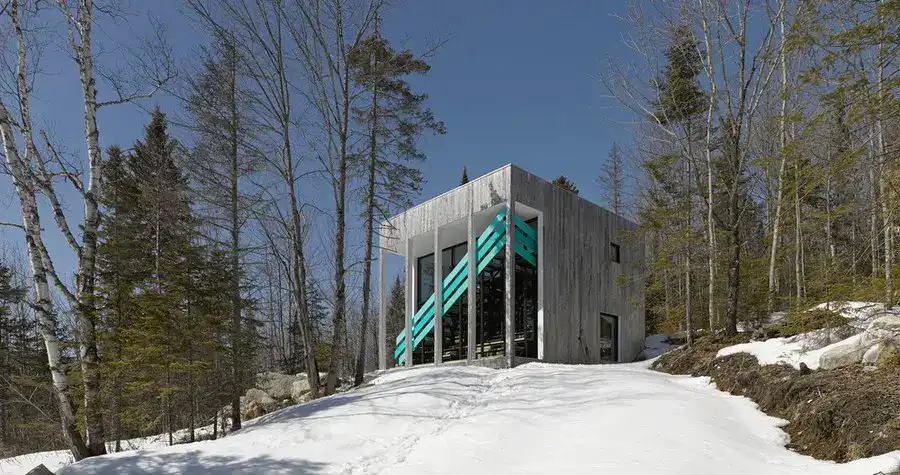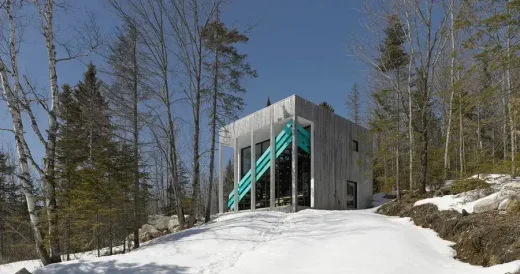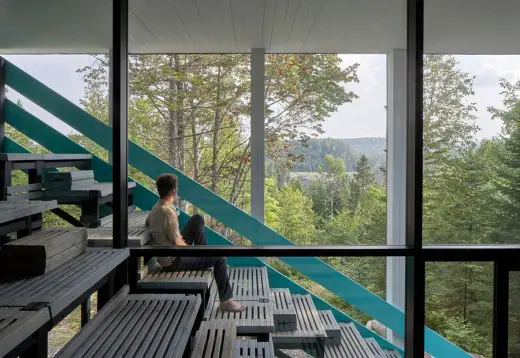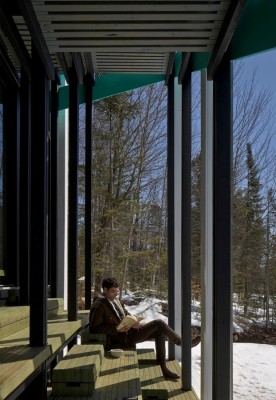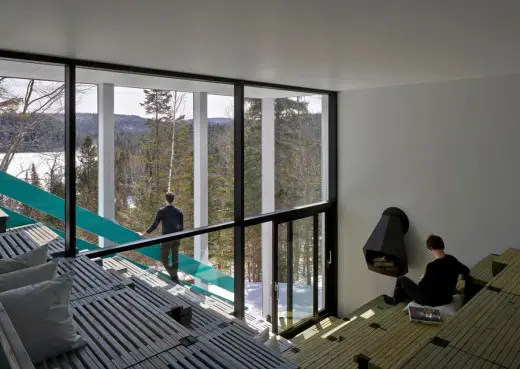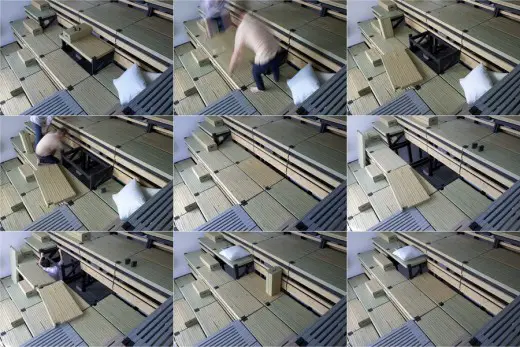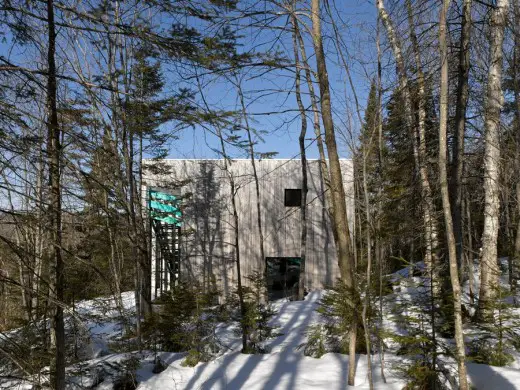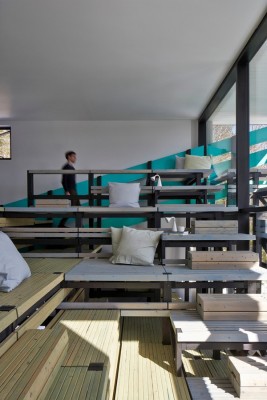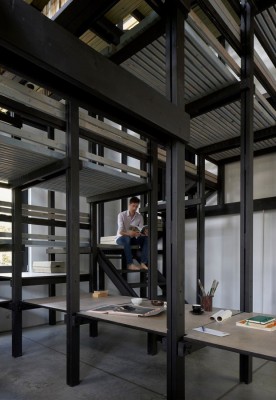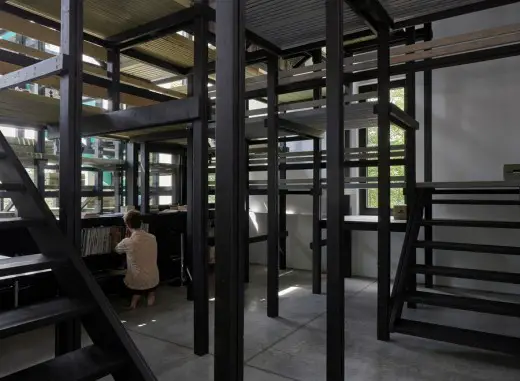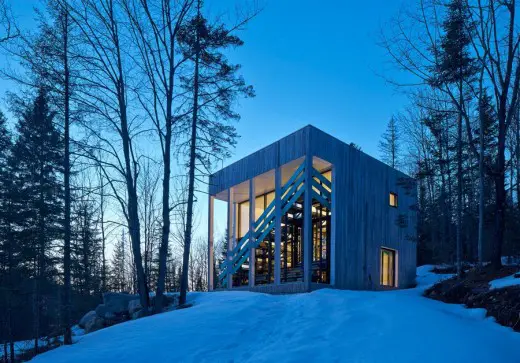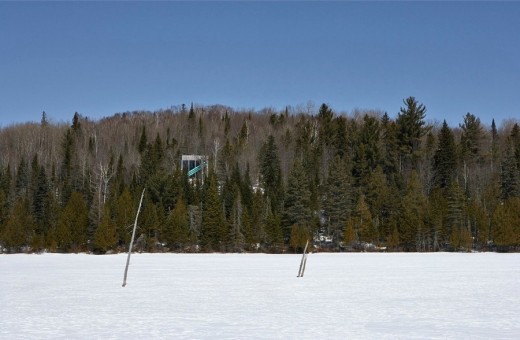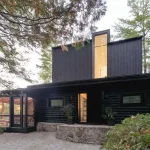Lake Jasper House, Chertsey home design, Matawinie property, Canada residence interior
Lake Jasper House in Matawinie
New Quebec Home in Matawinie: Canadian Contemporary Flexible Building design by Architecturama
Design: Architecturama
Location: Chertsey, Matawinie, Quebec, Canada
Lake Jasper House in Chertsey, Matawinie
16 Oct 2019
Lake Jasper House in Chertsey
Whether visiting alone, with a large group of guests or as a family, the owners were looking for a relaxed, welcoming environment, conceptually similar to a cottage yet more refined, particularly in the relationships among spaces and between people. The goal was to have a present, living and enthusiastic architecture that engages the senses.
The design process, grounded in the setting, symbiosis with the site and a reduced environmental footprint, led to a reflection process on the functional elements and their optimization.
Minimum/maximum
The functions are divided into two types. Minimalist spaces housing functions requiring built-in elements or greater privacy are clustered on the north side. A “maximal” space, containing all other functions, occupies the south side and allows free use of the space, open to interpretation and transformation.
Bleacher-style benches
Bleacher-style benches, meeting at right angles, are built into the main space. They are simultaneously oversized furniture, an agora, a circulation area, filters, dividers, bookshelves, structural elements, etc. They can be modified in three ways: as movable blocks that can be rearranged at will (for use as end tables, backrests, steps, etc.), as intermediate levels attached to the main structure but capable of being reconfigured regularly and, collectively, as benches resting on the concrete slab, which can be reassembled in an entirely different way.
On the south and west faces respectively, the benches are at ground level. Their incline extends the site’s topography to the inside of the house, thereby accentuating it. As a result, spaces are defined in a more or less porous manner. At the top the benches make it possible to enjoy the view while maintaining physical and visual continuity with the ground. Near the kitchen, the benches become both food preparation areas and tables seating up to eight people.
The bench system is modular, and most of its constituent elements are standardized.
Senses and perception
Contrasts, ambiances, materiality, lighting quality and modulated contact with the outside come together to create sensory experiences.
As if suspended between treetops, nature’s immanent spectacle takes place. In this observatory, the impression is both of being protected and projected. Both solemn and spiritual, the house comes to life and becomes something entirely different when several people are present. The agora layout is well suited to interaction. A fireplace, movie projector and feather cushions help people enjoy the space.
The space below is introverted and dense. Its light, filtered by the benches, is complex and ever-changing. Its many thin columns resemble trees in the forest.
The minimal spaces are embracing and almost cave-like with their soft, dark, rich finishes.
At first glance, the difference between natural and built forms is highlighted. The close links uniting the architecture with nature emerge through ambiances, relationships, mimetic qualities, materials and light.
Sustainable construction
From the site-selection phase, optimizing bioclimatic potential was one of the project goals. By building the structure with a fully south-facing façade, the arrangement of the parcel made it possible to make the most of a set of windows with a fine view that maximize passive solar heating. A large overhang, designed to make use of the changing angle of the sun, prevents overheating in summer while admitting as much winter sunlight as possible.
The building’s elevated position and its orientation allow effective natural ventilation. Front windows that open at the bottom and rear windows that open at the top promote cross-drafts and take advantage of differential pressure.
With its cube shape and advantageous ratio of envelope to usable volume, the structure promotes energy efficiency and economical use of materials. The shape also made a smaller footprint possible.
The white cedar tongue-and-groove siding, sourced from a local sawmill, was left in its natural state.
Finalist at the 2015 Architecture Excellence Awards of the Ordre des architectes du Québec.
Lake Jasper House in Chertsey – Building Information
Typology: Residential
Area: 80 sqm (140 sqm floor area)
Conception: 2011-13
Construction: 2012-14
Architect: Architecturama
Project team: Sylvain Bilodeau, architecte, Nicolas Mathieu-Tremblay, architecte
Structure: Genivar (now WSP)
General Contractor: Les entreprises Sylvain Lachance
Exterior cladding: Éco-Cèdre Inc.
Photos: James Brittain Photography
Lake Jasper House in Chertsey images / information from Architecturama
Location: Chertsey, Quebec, Canada
Montréal Architecture Developments
Contemporary Montréal Buildings
Montreal Architecture Designs – chronological list
Montpellier Residence, Saint-Bruno, Montreal, Canada
Architects: Vives St-Laurent
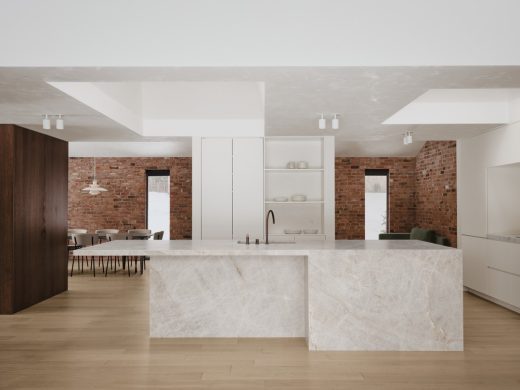
photo : Alex Lesage
Montpellier Residence, Saint-Bruno
La Barque Residence, Saint-Donat-de-Montcalm, Matawinie, Quebec
Architects: ACDF Architecture
La Barque Residence in Saint-Donat-de-Montcalm
Ice Shore House, Verdun
Architect: INDESIGN inc CONRATH architecte
Ice Shore House in Verdun
La Couleuvre
Design: NatureHumaine
Montreal Flat Extension
Montreal Architectural Tours – Quebec architectural tours by e-architect
Canadian Architectural Designs
Canadian Building Designs – architectural selection below:
Comments / photos for the Lake Jasper House in Chertsey page welcome
Website: Architecturama

